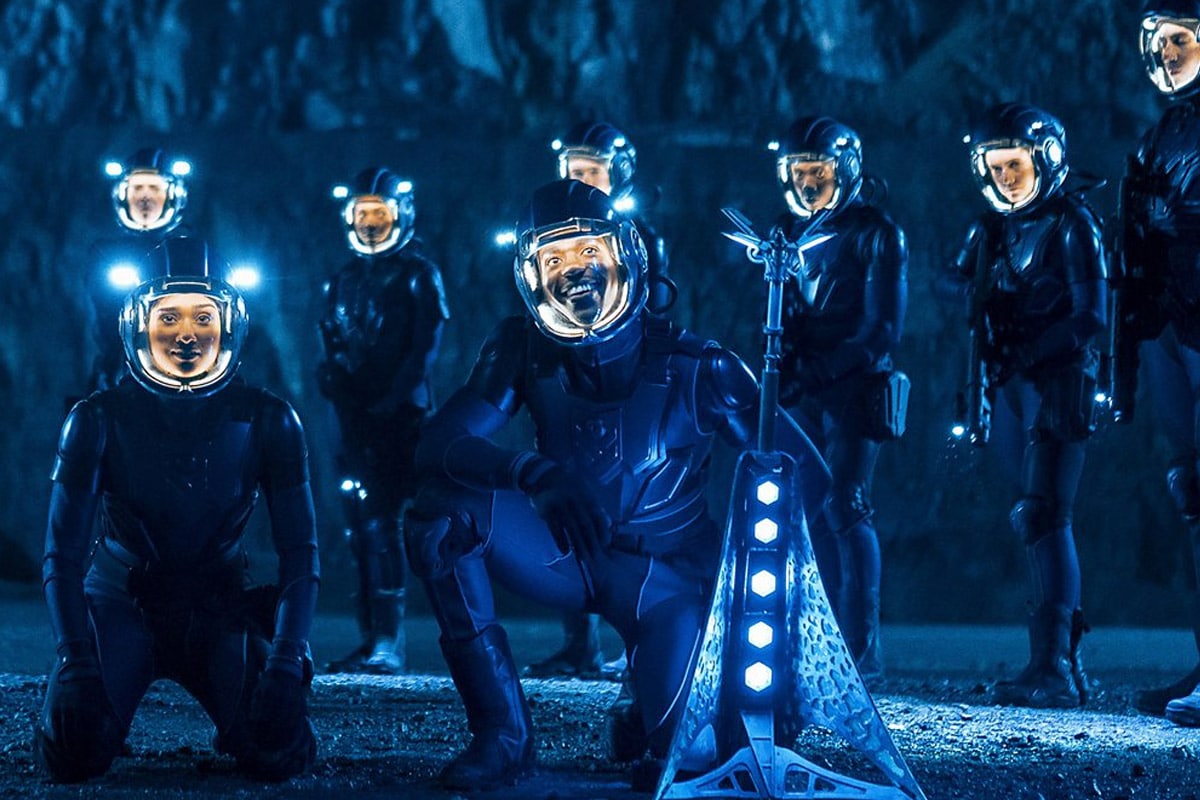- Series: 10
- Episode: Ten
- Duration: 44 minutes
- Writer: Rona Munro
- Director: Charles Palmer
Trust me, this is not my first rodeo
What a difference a week makes. Just when it looked like this promising series was spiraling to disaster, Matt Lucas walks onto the wilds of second century Aberdeen in a dressing gown.
What happens over the next, all-too-brief 44 minutes is quite extraordinary. There’s nothing incredibly dazzling about The Eaters of Light on first watch, or second. It’s not evidently an immediate classic. Indeed, those further viewings expose it’s distinct lack of perfection. But over the best part of an hour in which it deliberately, willfully and sneakily drags Doctor Who into some new disconcerting places, it proves itself a masterclass in demonstrating how to juggle the show’s big ideas, a fairly generic monster of the week, and a considerable cast to boot. It succeeds where other episodes have failed. The inane monster, revealled within 10 minutes, equipped with a vague light sucking power and perfectly non-descript, is that way for a reason. The emphasis very much falls on the humans — or humaoids — three sets, each united in some neat epiphanies by the TARDIS telepathic citcuit that we, like, Bill, have long taken for granted.
The Eaters of Light takes each of the TARDIS crew out of character, and somehow doesn’t undermine them. And that’s quite a trick at any time, least of all in the closing stages of a series.

In the TARDIS
I’m against it… Against charm
There’s little messing about at the top of this adventure. Munro presents a plucky companion and surly Doctor in competition, a rather shocking reminder of the university tutor/student relationship that feels long gone. And then, just as quickly, Munro splits the TARDIS crew up. While a tad too much coninidence ensures, it’s refreshing to have companion dispatched and immediately, compellingly imperiled, as much as to have the pursuer instantly exposed as fallible through a slip. the first 20 minutes are dedicated to creating a comfort zone and then ripping a part of that away, including friendly, but scared, centurion. As companion, Bill sure does get left a lot. It’s a miracle, and a reassuring one, that she doesn’t die this time.
Still, many comfortable throwbacks are there from the start, a soft padding that reminds us of some of the central Who tenets that have a tendency to go walkabout for too long. Having traditionally split the TARDIS crew, it’s when they’re reunited that the dramatic strands really connect. It ticks along in the way that so many Who stories should, but that doesn’t mean The Eaters of Light is conventional.
Matt Lucas’ Nardole is slightly more annoying than usual here, but much of that pales in some more sparkling dialogue with Capaldi. In the logic of the series, Nardole’s character has taken a tangent. Carping on about the vault one minute and utterly inaprorpiate the next, he’s a reminder of how unsatisfying the mystery hidden in the basement of the university was.

Ruggedy Man
It’s like a mass sulk
Munro’s real interest here, and probably greatest achievement is in writing a rugged Twelfth Doctor. He’s rarely been ruder, more abusive, and more prone to random, misplaced bouts of (apparently) selfless stupidity. A story that sticks out in comparison is Series Eight’s In the Forest of the Night. That found the Twelfth Doctor similarly near the end of a series, but one where he continually confronted whether he really was an utter space douche — and could ‘reasonably’ reject a small girl’s request for help. At the end of this series, it’s quite remarkable to find such prolonged attacks on, admittedly, culpable, children. All the more so as they’re the ones to rise above it come the end.
Nostalgia
You sound like children
You sound like children too
But as becomes clear at the head of the third act,this is really a Peter Pan tale. There are Lost Boys on each side, only united against their true opposition when one of fiction’s greatest Peter Pans appears. Although the Doctor’s hardly on his best behaviour, nor impish. The picts may well have been Captan Hook and his pirates considering how rude the Time Lord is.

The Plan
Oh stop being brave, I can’t stand brave people
Come the end, it’s odd that, for once, the Doctor finally has a plan — it’s been a while. In fact, not having one has become a cemented trademark in the past decade. It’s odder, although not unprecedented, that this plan is his own sacrifice (“I can hold them back til the sun goes out”). There’s a real weight to this incarnation — and not just the reaction to the previous two, younger Doctors. He’s notably more bullish than he has been for some time. Without the mania of The Lie of the Land, but also railing on the Pict youth ‘barbarians’ after hiding and covering in front of a weakened army division last week. With all the emphasis on the humans facing danger and adversity, the Doctor’s journey is the masterstroke. Rona Munro manages to to cast a new light on the main man, from Bill’s insightful revelation that he only hears a universe of children to the stark reality of life in that universe: “And they will keep eating, until there’s no sides left”.

Past References
To protect a muddy little hillside you doomed a whole world
Peter Pan’s not the only, not strongest, reference in this episode. It’s worth noting the great similarities to last week’s episode, Mark Gatiss’ Empress of Mars. It’s the kind of scheduling clash that has scuppered series before, see the recurrent night terrors in the sixth year or repetitive robots in the eighth. But here the quality carries it as more of a correction. The Eaters of Light picks up the same modern pre-title sequence, a landscape marker and even imperils Bill with a Alice-type hole to fall through near the start. There’s the clash of the two military clans and an obsession with references. But all falls under a far more deft hand.
Of course, there’s more tactile to work with pitching Picts against Romans, compared to overblown red soldiers and Ice Warriors. Romans have played their part in Who before of course, and under Moffat’s tenure. But seldom have they packed this wallop. And that’s saying something considering how The Pandorica Opens the ending is. The structure creates a sense of the theatrical, and that’s no insult, packing both sides of a broad cast out with some fine actors and giving most their moments of solemnity and action . Just before the rivals meet, stalking corridors with flaming torches is when the “sheer weight of the quality becomes clear. It musters up something, few other have — even with some unsurprising twists “It’s a labyrinth”. When the Picts and Romans do meet, one line to Bill (“Are you their champion now?” says Kar, having previously seen her as an enemy and surely not piecing this together with the Doctor’s search) betrays a missing scene or loose edit, but it says a lot that this scarcely matters
There are mirrors with Munro’s previous story, classic era-closer Survival, if you look for them. The modern day link to an alternative worlds (this time the past), the early viewpoint from the snarling creature. This time it’s a far straighter bat than the kitlings that stalked late 1980s Perivale.
It’s hard not to see the Forth Doctor connection once again this series, with the unavoidable vibe of Season 16’s The Stones of Blood and a playful firecracker escape reminiscent of Season 13’s Brain of Morbius. The crows, naturally ominous, are a bit close to last series’ ravens. Their gathering gloom isn’t not helped by repeated FX shots, and could have benefited form having a greater link to the creature itself.
There’s some glorious old school Who logic in it though. “The crows aren’t sulking, they’re remembering”.
But the really satisfying links come from other fiction. Although under-cooked, the elemental, tentacled creatures breaking from their dimension bring a welcome dollop of Lovecraft to Doctor Who. And then there’s the joyous references to some classic children’s science fiction. In particular,
William Mayne’s mid-1960s book Earthfasts. With Munro, Moffat and Capaldi forming this Doctor’s final strong Scottish creative block it’s little surprise that the adventure embraces their homeland. And wryly too, “It’s Scotland, it’s supposed to be damp”.

In the Legion and the Tribe
There’s a big bad wolf of a monster out there and you’re in a house of sticks
The Eaters of Light find its real strength in its structure. The Latin chat that reveals the TARDIS intervention in communication, “I understand you,” is neat, but notable for not clicking too obtrusively at this point in the series. Munro brings out Bill’s intelligence in a way that others have struggled, especially in the last few weeks. While last week she could match a film to a situation, here she’s applying her academic interests. Even more notable, few other writers have managed to create quiet space in their stories for these kind of moments. Sarah Dollard is one, in both of her tales, and Neil Cross perhaps the most accomplished in his haunted house adventure Hide. Rona Munro can be added to the short list of writers who take time to add this oh-so important part of Who.
But Munro’s real trick is just that: a trick. A magic trick — to measure it in the structural sense:
The Pledge: The simple dispatch and ruse, what happened to the Ninth Legion — a well known, popular culture riddle and well overdue a Who-spin.
The Turn: Early on, revealing not only that the Ninth are beyond saving but revealing the cause, early on.
The Prestige: The Doctor, literally beaten by kids. The twist at the tale end of the is Rona Munro’s worked some kind of magic, and not a moment too soon.
Stunning moment
And there’s music. Always music
Well, we had to a some point — Let’s hand it to Murray Gold’s music — utterly superb, glorious, aching back to wistful celtic sources and children’s TV serials of yesteryear. 12 years of superb service and long may it continue.
Everyday hook of the week
What did you do, throw your action figures at them
Daddy day care. With Nardole mentally removed from the role he’d grown into, the Doctor is defiantly the only adult in this piece, which only goes to reinforce how immature and prone to terrible knee-jerk decisions he is.
Doctor look of the week
A clear winner. Capaldi’s withering response to Matt Lucas’ “Death by Scotland”
Production touch of the week
There’s some gorgeous moments, but many are underplayed. For it’s extraordinary step away from the expected, it has to go to the vivid technicolour monster, with director Charles Palmer working some magic with the colours and chiaroscuro of the piece.
A Jokerside View
Cthulhu wins. No, scratch that. the music makes much more sense when an 18th century drummer boy steps from the hillside and freaks everyone into cooperation
Vault action
You’ve still got to face your beast anyway, can you do that?
Zilch, nothing, nada. Even the Doctor’s abandoned it. He’s still wary of course, but the Vault is truly revealed to be a mere holding cell. The Master’s danger in this series is, so far, suspense not surprise. Still, Munro draws out a staunch parallel between Kar and the Doctor as gatekeeper and vault keeper. it could have been even more powerful earlier in the series, despite the emotional coda.
Missy now mostly resembles the non-canon fate of the rogue in Paul Cornell’s 40th anniversary special Scream of the Shalka. Stuck, and an excellent mechanic to have on hand. “So, now he’s getting TARDIS maintenance for free?”
Worth noting at this point that the concept of Empire rears its head once again, “Their work is robbery, slaughter, plunder. they do this work and they call it empire” says Kar at one point. Hmm, surely the constant visits to empires and the often squandered chance to comment on them can’t be a coincidence? Reminiscent of the ‘soldier’ theme that ran parallel to the Doctor’s turmoil in the Eighth Series, it’s likely not to feed into the Missy-shaped arc (tellingly, again), but complement it in a couple of weeks.
Verdict
That’s the trouble with hope — it’s hard to resist
A twist on Peter Pan, dipping into the nostalgia of children’s stories, tied to the essence of ancient Britain. And a compelling behind-the-scenes link to the Classic era of Doctor Who.
What return for Rona Munro this is. Structurally, it may sit a little close to last week’s Empress of Mars, but everything in ancient Britain is richer. The characterisation, the references. This is a fine slice of Who that rises to its berth late in the series and finds less obvious roots through to the genre’s past. And even manages to cast a fresh light on our old and fast-ailing Time Lord. The experiment in nostalgia worked, a cycle is complete.
Review previously published on Medium (July 1, 2017)









0 Comments